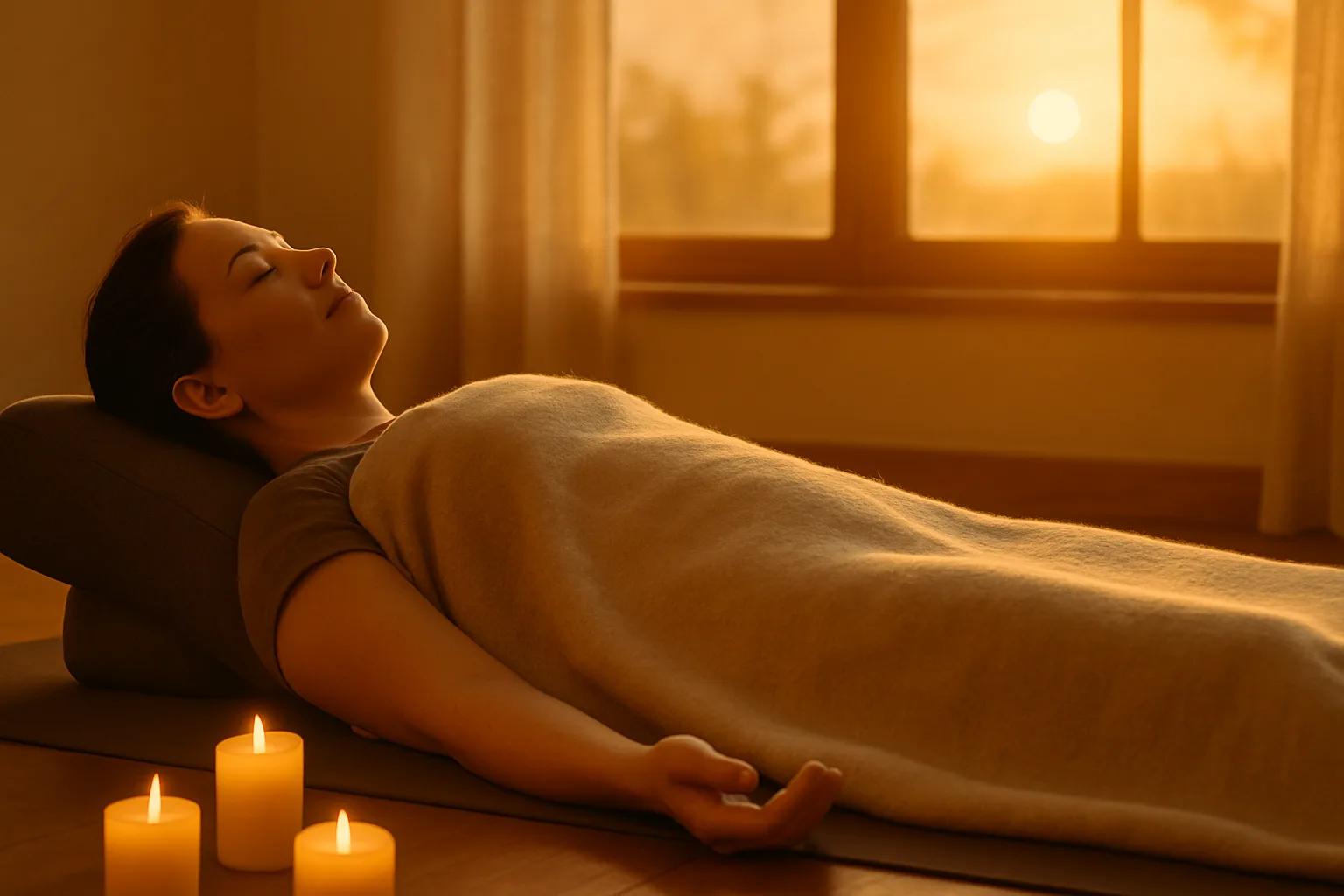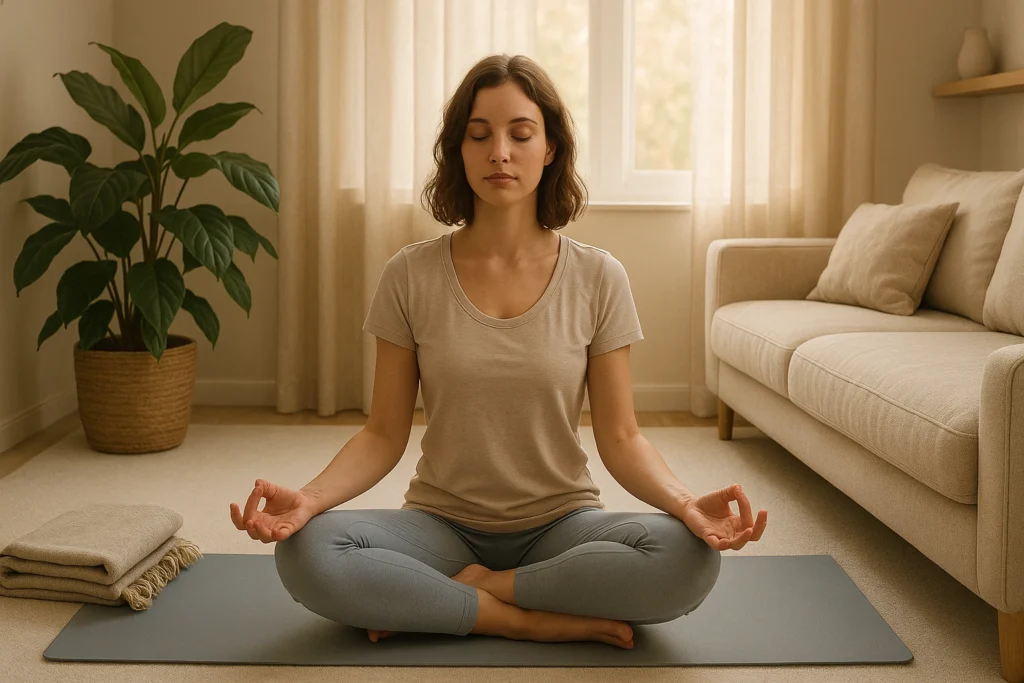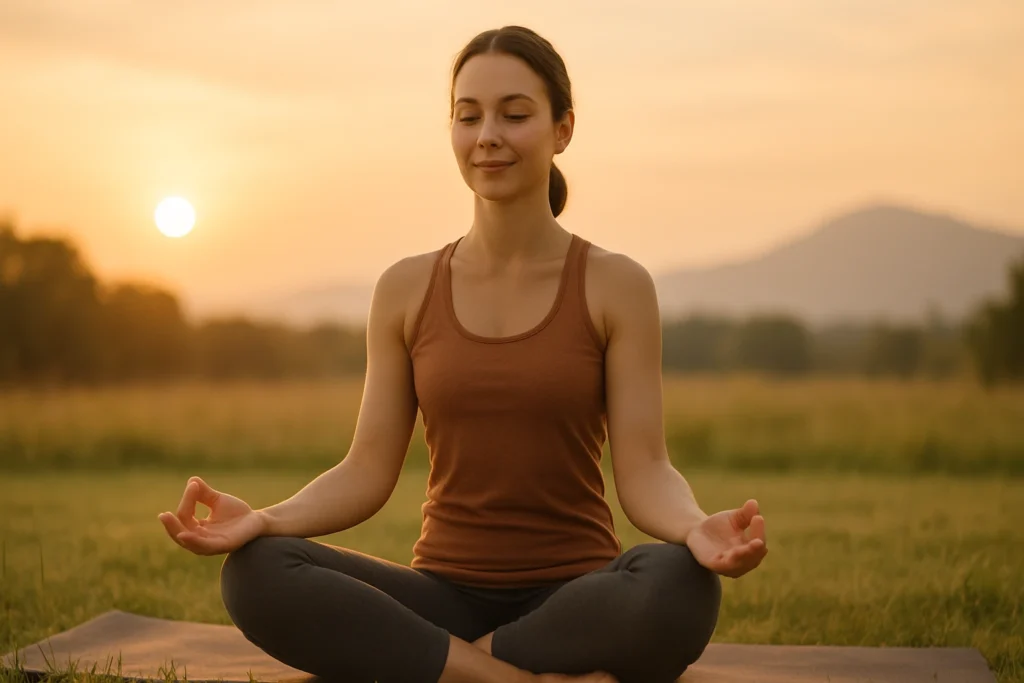
Feeling overwhelmed or achy? After a long day, your body and mind crave a reset. Whether you’re easing post-workout soreness, healing from an injury, or managing daily stress, recovery yoga offers a gentle path back to balance — no pushing, just support. The 10 restorative poses below are designed to soothe your body and calm your mind — for the bigger picture, see our guide to yoga for specialized health.
Table of Contents
Key Takeaways (At a Glance)
- Recovery yoga is a gentle approach that may ease aches, lower stress, and support your body as it heals from minor strain.
- It leans on restorative positions with props (blankets, bolsters, blocks) to enable deep relaxation.
- These poses may help you feel calmer and more comfortable; with professional clearance they can complement recovery from minor strain.
- Always tune into what your body needs and check with a doctor or therapist if injuries are a concern.
- Even a short, regular practice can support both physical and mental health.
This post has affiliate links. We may earn a commission. Learn more.
What is Recovery Yoga?
Unlike vigorous yoga styles, recovery yoga focuses on slowing down and nurturing your body. It supports rest and recovery through gentle, supported poses. Think of it as a fully supported rest for your muscles and mind. Props like blankets, bolsters, and blocks support your body, allowing relaxation without effort — ideal when you’re tired, stressed, or recovering from physical strain.
Research suggests yoga can reduce perceived stress and improve well-being, with mixed findings on cortisol depending on the program. For example, a 2024 randomized trial in university students reported lower perceived stress and anxiety after a 12-week program, and a 2024 review summarizes stress-related biosignals potentially improved by yoga.
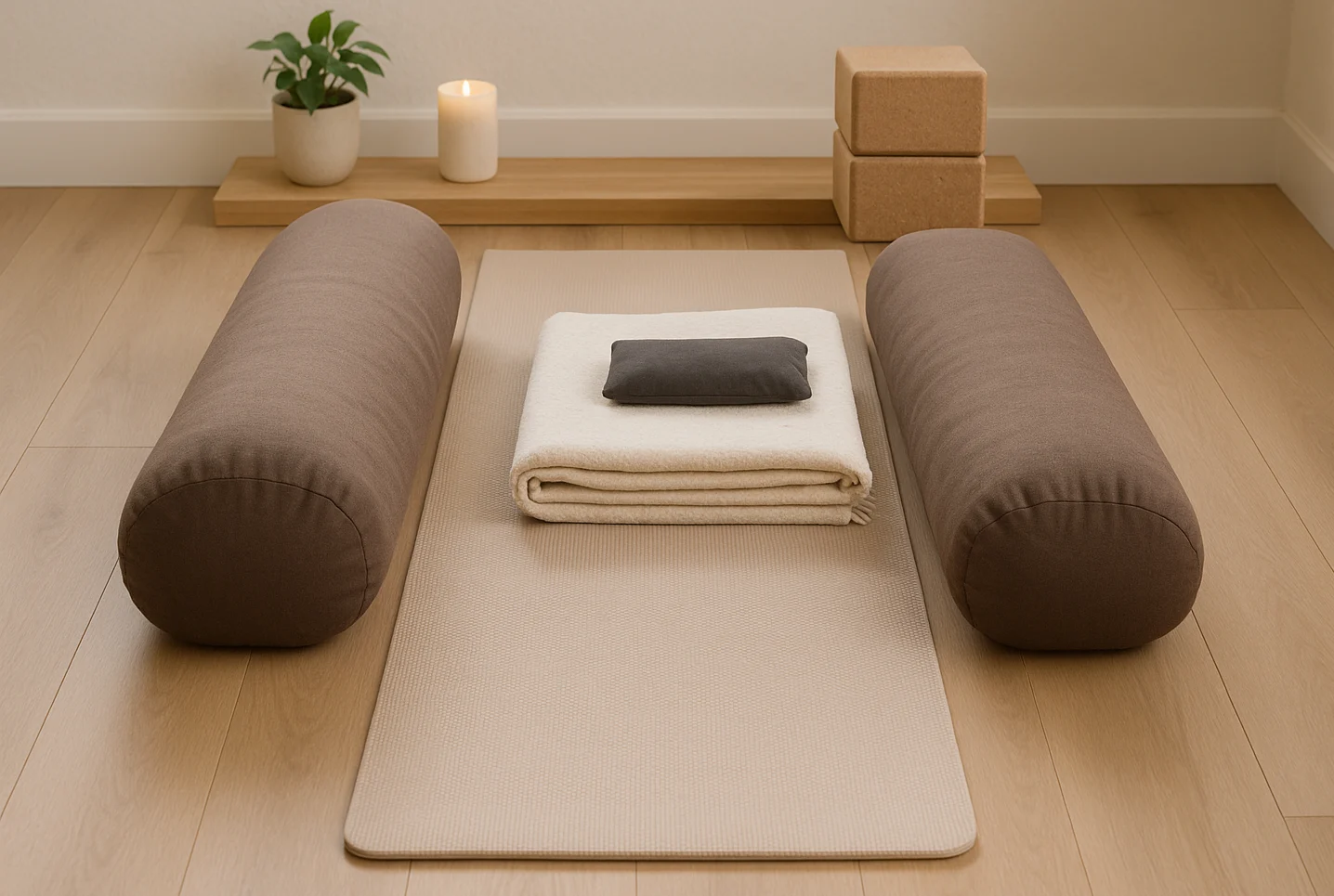
Why Recovery Yoga Matters for Healing
Your body has an incredible capacity to heal, and this practice may help by:
- Calming the Nervous System: When stress or pain triggers “fight or flight,” supported poses help shift toward “rest and digest.” Learn more about managing stress with breathwork.
- Softening Muscle Tension: Props allow tissues to release without strain, especially in the back, neck, and hips.
- Supporting Recovery: Gentle positioning and rest may help you feel more at ease; evidence on specific circulation effects is mixed.
- Improving Stress Markers: Early research suggests some programs are associated with changes in stress-related biomarkers (e.g., cortisol dynamics), though findings vary.
- Enhancing Mental Well-being: Gentle attention to breath can ease anxiety and lift mood.
- Setting Up Better Sleep: A relaxed body and mind make rest easier.
“This isn’t about stretching deeper; it’s about relaxing deeper. It teaches your body how to let go.”
Safety Tips for Yoga for Injury Recovery
Keep things safe, especially if you’re healing from an injury:
- Listen to Your Body: Skip pushing through discomfort; choose gentle stretches or soft releases.
- Chat with a Doctor: For serious injuries or ongoing issues, get professional guidance.
- Lean on Props: Blankets, bolsters, and blocks are your allies. See tips for mindful movement to enhance your setup.
- Take It Slow: Ease into positions to avoid strain — especially with yoga for injury recovery in mind.
- Breathe Easy: Slow, steady breaths can help calm the nervous system.
- Stay Hydrated: Sip water before and after to support recovery.
- Create a Calm Vibe: Dim lights, play soft music, or light a candle.
At its heart, this journey is about nurturing yourself. Be gentle; your body will respond — and keep recovery yoga slow and supported if you’re easing back from injury.
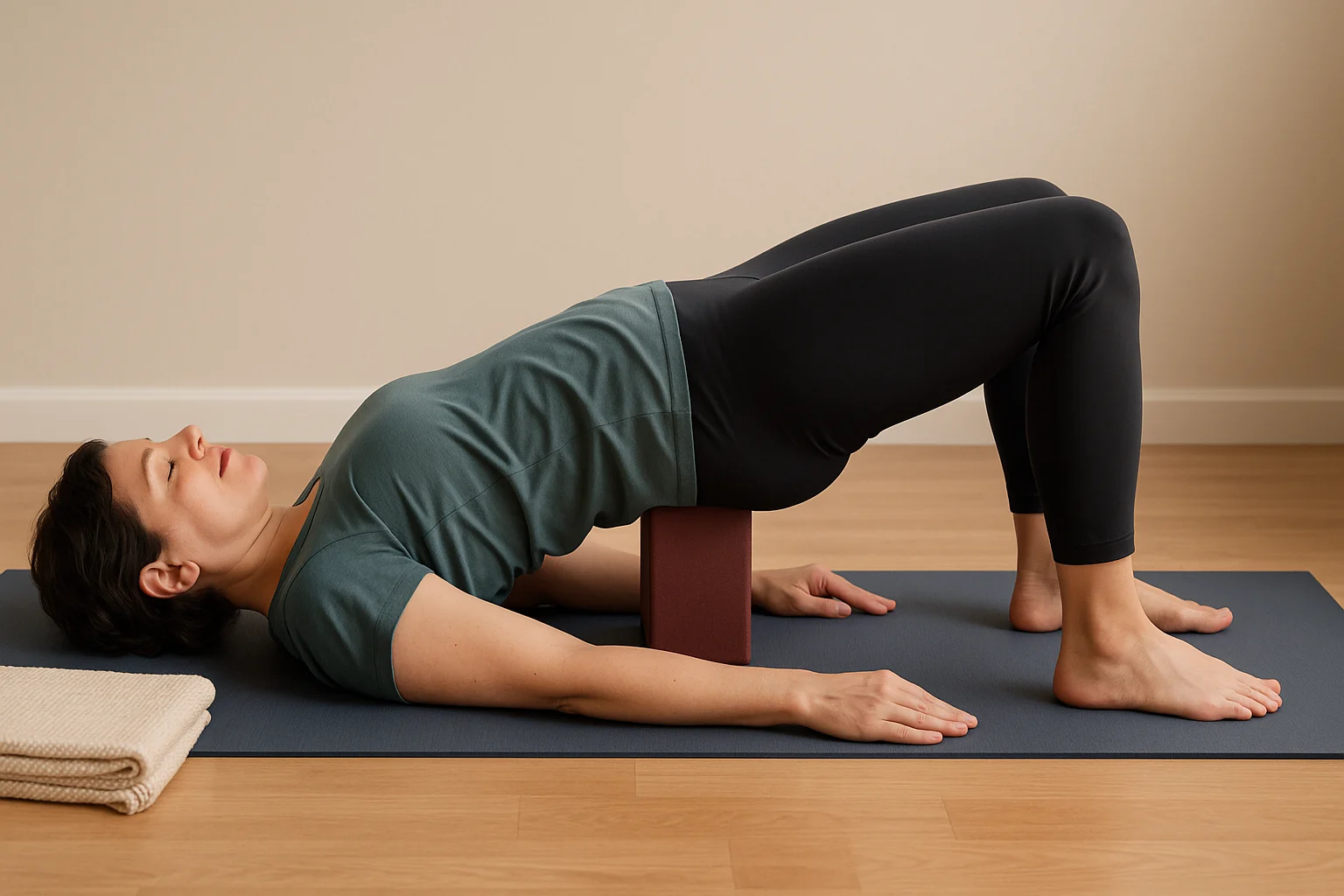
10 Restorative Poses to Try
These 10 restorative poses can help you unwind and release tension—without forcing a stretch. Need a midday reset? Try this quick desk yoga for posture relief.
Restorative Yoga Positions: Setup & Props
Grab a blanket or two and a block if you have one. Pad the spots that talk to you—under knees, behind the low back, or beneath the head—so the pose meets your body. If your shoulders creep up or your breath gets tight, add a little height and try again.
Child’s Pose (Balasana)
Give your hips somewhere to land. If knees feel tight, widen them and slide a pillow under your chest. Rest your forehead on the mat or stacked fists—aim for easy breathing and a soft lower back.
- How to do it: Start on hands and knees. Bring big toes together, adjust knee width, and sit hips back toward heels. Reach arms forward, resting forehead on the mat or stacked fists. Add a pillow under your chest for comfort.
- Hold time: 3–5 minutes.
- Props needed: Blanket or pillow under forehead or chest.
- Benefits: Can calm the nervous system, may help relieve stress, and gently stretch the hips, thighs, and ankles.
- Tips: Place a blanket between hips and heels if needed.
Legs-Up-the-Wall (Viparita Karani)
This gentle legs-up shape can soothe tired legs and help settle the mind.
- How to do it: Sit with one hip against a wall, swing legs up, and lie back, forming an L-shape. Place a blanket under your hips. Rest arms by sides, palms up.
- Hold time: 5–15 minutes.
- Props needed: Folded blanket or bolster under hips.
- Benefits: May relieve leg fatigue, lightly stretch the hamstrings, and support relaxation.
- Tips: Move a bit away from the wall if hamstrings feel tight.
Supine Bound Angle Pose (Supta Baddha Konasana)
A gentle hip opener that helps release tension and encourages calm.
- How to do it: Lie on your back, bring soles together, and let knees fall outward. Support knees with pillows. Rest hands on belly or by sides.
- Hold time: 5–10 minutes.
- Props needed: Pillows under each knee.
- Benefits: Stretches inner thighs, eases lower back tension, supports relaxation.
- Tips: Add more support under knees as needed.
Supported Bridge Pose (Setu Bandhasana)
A mild backbend that opens the chest and soothes the body.
- How to do it: Lie on your back, knees bent, feet hip-width. Lift hips slightly, slide a block or pillow under the sacrum, and rest hips on it. Arms by sides or in a T-shape.
- Hold time: 3–5 minutes.
- Props needed: Yoga block or firm pillow.
- Benefits: Gently stretches the chest and spine; may help ease feelings of stress and fatigue.
- Tips: Ensure support rests under the sacrum, not the lower spine.
Reclined Spinal Twist (Supta Matsyendrasana)
This twist helps release tension in the back and hips.
- How to do it: Lie on your back, hug knees to chest. Extend right arm, let knees fall left, resting on a pillow if needed. Look right or keep head neutral. Switch sides after a few minutes.
- Hold time: 2–3 minutes per side.
- Props needed: Pillow or blanket under knees.
- Benefits: Stretches the back and hips; may support digestion; can calm the mind.
- Tips: Keep shoulders grounded; avoid forcing knees down.
Constructive Rest Pose
Simple and effective for neutral alignment and softening tension.
- How to do it: Lie on your back, knees bent, feet flat, hip-width apart. Let knees rest against each other. Hands on belly or by sides.
- Hold time: 5–15 minutes.
- Props needed: Optional pillow under head.
- Benefits: Releases lower back and hip tension; calms the nervous system.
- Tips: Allow your back to settle into the floor.
Supported Savasana (Corpse Pose)
The classic position for deep rest and integration.
- How to do it: Lie on your back, place a bolster under knees and a blanket under head. Cover with a blanket if chilly. Let arms rest, palms up, feet fall open. Close eyes, focus on breath.
- Hold time: 10–20 minutes.
- Props needed: Bolster or blanket under knees; blanket under head.
- Benefits: May help reduce stress and fatigue; can support better sleep.
- Tips: Stay still to allow deeper relaxation.
Parsva Balasana (Thread the Needle)
A gentle twist for the upper back and shoulders.
- How to do it: From tabletop, slide right arm under left armpit, palm up, resting shoulder and head on the mat. Left hand stays in front or walks forward. Switch sides after a few minutes.
- Hold time: 1–2 minutes per side.
- Props needed: Blanket under head or shoulder if needed.
- Benefits: Stretches upper back and shoulders; can relieve neck tension.
- Tips: Let the shoulder soften without forcing it down.
Gentle Sphinx Pose (Salamba Bhujangasana)
A mild backbend that can support the lower back and open the chest.
- How to do it: Lie on your belly, elbows under shoulders, forearms flat. Press into forearms and lift the chest, keeping the neck long. Relax glutes.
- Hold time: 2–5 minutes.
- Props needed: Optional pillow under hips.
- Benefits: Can gently engage the back muscles, stretches the chest, and supports relaxation.
- Tips: Move elbows forward if the lower back feels pinched.
Restorative Fish Pose (Matsyasana — supported)
This heart opener counteracts hunching and releases chest and neck tension.
- How to do it: Sit with a bolster behind you, a few inches from the lower back. Lie back with the bolster supporting the upper back. Head rests on the floor or a blanket. Extend legs or keep feet flat. Arms by sides, palms up.
- Hold time: 3–5 minutes.
- Props needed: Bolster or pillow; optional blanket for head.
- Benefits: Stretches chest and throat; may reduce fatigue and ease anxiety.
- Tips: Adjust bolster height to stay comfortable.
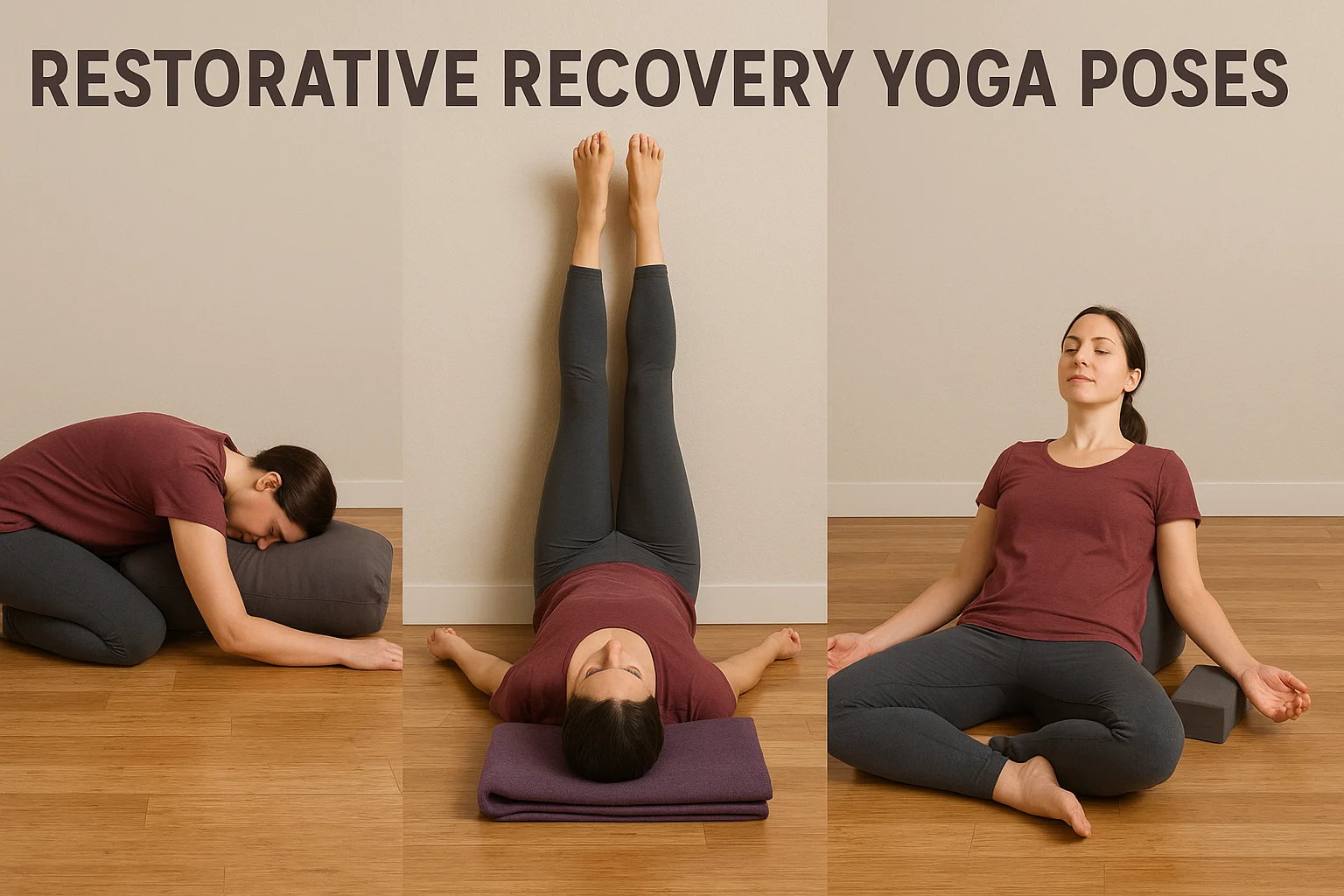
Interactive Pose Selector
Find the support that feels right today with this interactive tool — it suggests recovery yoga poses by focus. Prefer something simple at home? Try our no-equipment yoga routines.
Focus Selector
What would feel best today?
Select a focus above to see recommended poses!
Frequently Asked Questions About Recovery Yoga
Fully supported poses are usually the safest. Try Child’s Pose with a pillow, Legs-Up-the-Wall, or Supported Savasana. Use props to reduce strain and move out of anything that doesn’t feel comfortable.
Many people feel good with 10–15 minutes most days, or 20–30 minutes two to three times per week. Let comfort and ease set the pace for you.
To help your body and mind settle. Gentle, supported positions can reduce stress, soften muscle tension, and complement recovery from workouts or minor strains.
People often notice less perceived stress, better sleep, and relief from general muscle tightness. Moving slowly with support can also lift mood and encourage relaxation.
They’re closely related. Both use props for rest and relaxation; “recovery” simply emphasizes support during healing from stress, overuse, or minor injury.
Yes. Start with fully supported postures like Supported Savasana and focus on easy breathing. Skip anything that causes discomfort and adjust props until you feel at ease.
Your Next Steps
Pick two poses tonight and make them comfy—pillow under the knees, blanket under the head, slow breath in and out. If your mind spins, count five breaths and let the exhale lengthen. That’s it. Small, steady steps work. Recovery yoga tends to feel best when it’s consistent, even 10–15 minutes. When you want a simple plan for home, explore our home-based routines and build from there.
